Pontus Stenetorp
Multilingual Language Model Pretraining using Machine-translated Data
Feb 18, 2025Abstract:High-resource languages such as English, enables the pretraining of high-quality large language models (LLMs). The same can not be said for most other languages as LLMs still underperform for non-English languages, likely due to a gap in the quality and diversity of the available multilingual pretraining corpora. In this work, we find that machine-translated texts from a single high-quality source language can contribute significantly to the pretraining quality of multilingual LLMs. We translate FineWeb-Edu, a high-quality English web dataset, into nine languages, resulting in a 1.7-trillion-token dataset, which we call TransWebEdu and pretrain a 1.3B-parameter model, TransWebLLM, from scratch on this dataset. Across nine non-English reasoning tasks, we show that TransWebLLM matches or outperforms state-of-the-art multilingual models trained using closed data, such as Llama3.2, Qwen2.5, and Gemma, despite using an order of magnitude less data. We demonstrate that adding less than 5% of TransWebEdu as domain-specific pretraining data sets a new state-of-the-art in Arabic, Italian, Indonesian, Swahili, and Welsh understanding and commonsense reasoning tasks. To promote reproducibility, we release our corpus, models, and training pipeline under Open Source Initiative-approved licenses.
Warmup Generations: A Task-Agnostic Approach for Guiding Sequence-to-Sequence Learning with Unsupervised Initial State Generation
Feb 17, 2025Abstract:Traditional supervised fine-tuning (SFT) strategies for sequence-to-sequence tasks often train models to directly generate the target output. Recent work has shown that guiding models with intermediate steps, such as keywords, outlines, or reasoning chains, can significantly improve performance, coherence, and interpretability. However, these methods often depend on predefined intermediate formats and annotated data, limiting their scalability and generalizability. In this work, we introduce a task-agnostic framework that enables models to generate intermediate "warmup" sequences. These warmup sequences, serving as an initial state for subsequent generation, are optimized to enhance the probability of generating the target sequence without relying on external supervision or human-designed structures. Drawing inspiration from reinforcement learning principles, our method iteratively refines these intermediate steps to maximize their contribution to the final output, similar to reward-driven optimization in reinforcement learning with human feedback. Experimental results across tasks such as translation, summarization, and multi-choice question answering for logical reasoning show that our approach outperforms traditional SFT methods, and offers a scalable and flexible solution for sequence-to-sequence tasks.
Lost in Inference: Rediscovering the Role of Natural Language Inference for Large Language Models
Nov 21, 2024Abstract:In the recent past, a popular way of evaluating natural language understanding (NLU), was to consider a model's ability to perform natural language inference (NLI) tasks. In this paper, we investigate if NLI tasks, that are rarely used for LLM evaluation, can still be informative for evaluating LLMs. Focusing on five different NLI benchmarks across six models of different scales, we investigate if they are able to discriminate models of different size and quality and how their accuracies develop during training. Furthermore, we investigate the extent to which the softmax distributions of models align with human distributions in cases where statements are ambiguous or vague. Overall, our results paint a positive picture for the NLI tasks: we find that they are able to discriminate well between models at various stages of training, yet are not (all) saturated. Furthermore, we find that while the similarity of model distributions with human label distributions increases with scale, it is still much higher than the similarity between two populations of humans, making it a potentially interesting statistic to consider.
Multilingual Pretraining Using a Large Corpus Machine-Translated from a Single Source Language
Oct 31, 2024
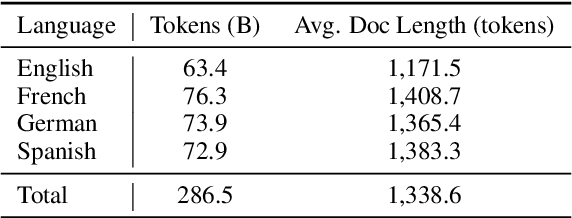
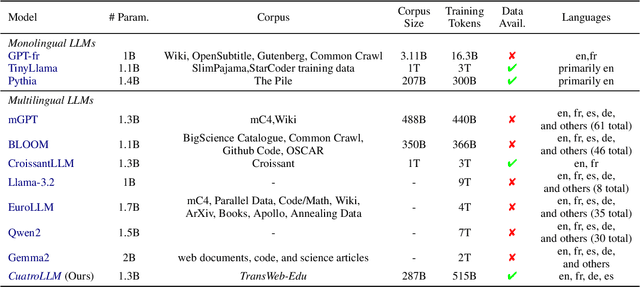

Abstract:English, as a very high-resource language, enables the pretraining of high-quality large language models (LLMs). The same cannot be said for most other languages, as leading LLMs still underperform for non-English languages, likely due to a gap in the quality and diversity of the available multilingual pretraining corpora. In this work, we find that machine-translated text from a single high-quality source language can contribute significantly to the pretraining of multilingual LLMs. We translate FineWeb-Edu, a high-quality English web dataset, into French, German, and Spanish, resulting in a final 300B-token dataset, which we call TransWeb-Edu, and pretrain a 1.3B-parameter model, CuatroLLM, from scratch on this dataset. Across five non-English reasoning tasks, we show that CuatroLLM matches or outperforms state-of-the-art multilingual models trained using closed data, such as Llama3.2 and Gemma2, despite using an order of magnitude less data, such as about 6% of the tokens used for Llama3.2's training. We further demonstrate that with additional domain-specific pretraining, amounting to less than 1% of TransWeb-Edu, CuatroLLM surpasses the state of the art in multilingual reasoning. To promote reproducibility, we release our corpus, models, and training pipeline under open licenses at hf.co/britllm/CuatroLLM.
Jet Expansions of Residual Computation
Oct 08, 2024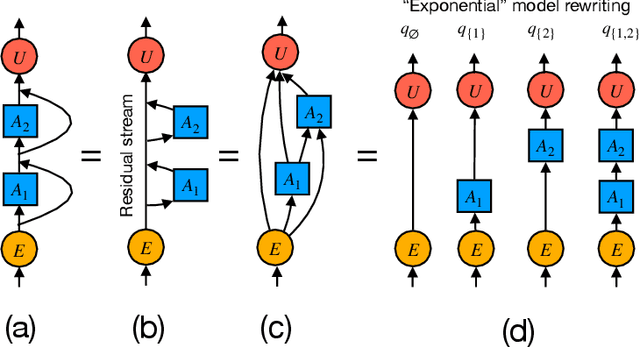

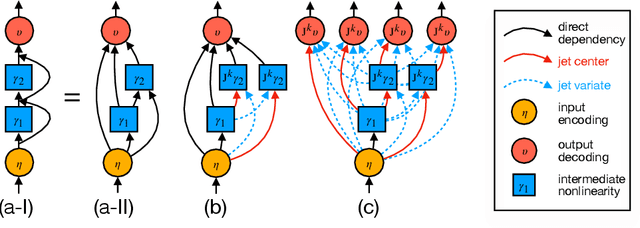
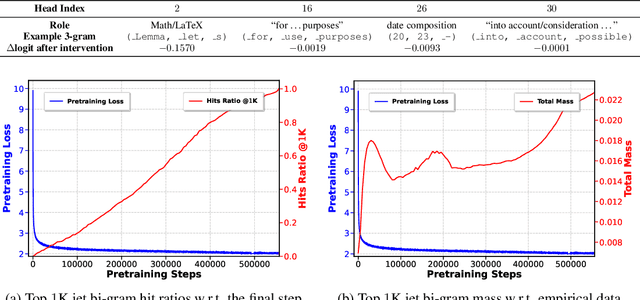
Abstract:We introduce a framework for expanding residual computational graphs using jets, operators that generalize truncated Taylor series. Our method provides a systematic approach to disentangle contributions of different computational paths to model predictions. In contrast to existing techniques such as distillation, probing, or early decoding, our expansions rely solely on the model itself and requires no data, training, or sampling from the model. We demonstrate how our framework grounds and subsumes logit lens, reveals a (super-)exponential path structure in the recursive residual depth and opens up several applications. These include sketching a transformer large language model with $n$-gram statistics extracted from its computations, and indexing the models' levels of toxicity knowledge. Our approach enables data-free analysis of residual computation for model interpretability, development, and evaluation.
Linguini: A benchmark for language-agnostic linguistic reasoning
Sep 18, 2024Abstract:We propose a new benchmark to measure a language model's linguistic reasoning skills without relying on pre-existing language-specific knowledge. The test covers 894 questions grouped in 160 problems across 75 (mostly) extremely low-resource languages, extracted from the International Linguistic Olympiad corpus. To attain high accuracy on this benchmark, models don't need previous knowledge of the tested language, as all the information needed to solve the linguistic puzzle is presented in the context. We find that, while all analyzed models rank below 25% accuracy, there is a significant gap between open and closed models, with the best-performing proprietary model at 24.05% and the best-performing open model at 8.84%.
Machine Translation Hallucination Detection for Low and High Resource Languages using Large Language Models
Jul 25, 2024Abstract:Recent advancements in massively multilingual machine translation systems have significantly enhanced translation accuracy; however, even the best performing systems still generate hallucinations, severely impacting user trust. Detecting hallucinations in Machine Translation (MT) remains a critical challenge, particularly since existing methods excel with High-Resource Languages (HRLs) but exhibit substantial limitations when applied to Low-Resource Languages (LRLs). This paper evaluates hallucination detection approaches using Large Language Models (LLMs) and semantic similarity within massively multilingual embeddings. Our study spans 16 language directions, covering HRLs, LRLs, with diverse scripts. We find that the choice of model is essential for performance. On average, for HRLs, Llama3-70B outperforms the previous state of the art by as much as 0.16 MCC (Matthews Correlation Coefficient). However, for LRLs we observe that Claude Sonnet outperforms other LLMs on average by 0.03 MCC. The key takeaway from our study is that LLMs can achieve performance comparable or even better than previously proposed models, despite not being explicitly trained for any machine translation task. However, their advantage is less significant for LRLs.
PISTOL: Dataset Compilation Pipeline for Structural Unlearning of LLMs
Jun 24, 2024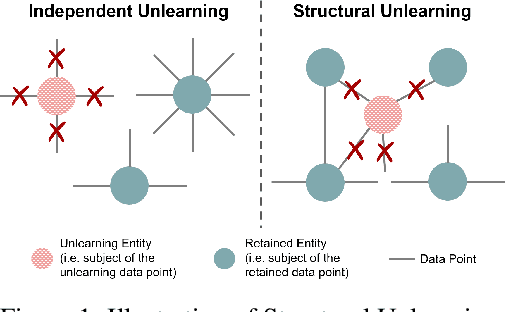
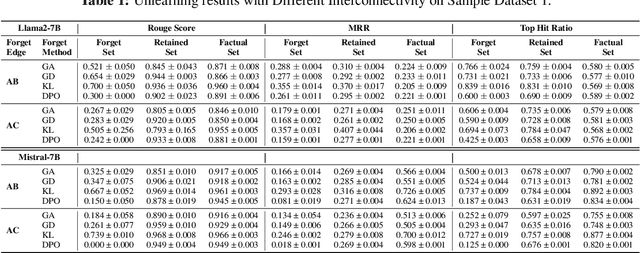

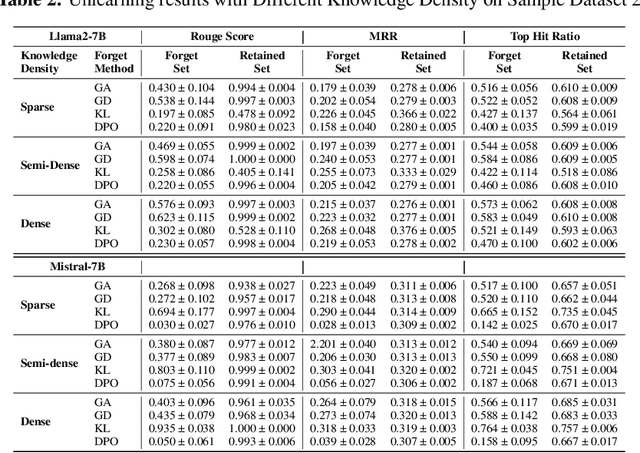
Abstract:Recently, machine unlearning, which seeks to erase specific data stored in the pre-trained or fine-tuned models, has emerged as a crucial protective measure for LLMs. However, unlearning approaches for LLMs that have been considered thus far have focused on the removal of independent data points and have not taken into account that the stored facts are logically connected to one another and form an implicit knowledge graph. To facilitate the development of structural unlearning methods, which are essential for the practical application of unlearning, we propose PISTOL, a pipeline for compiling multi-scenario datasets for benchmarking structural LLM unlearning. Additionally, leveraging sample datasets synthesized using PISTOL, we conducted benchmarks with four distinct unlearning methods on both Llama2-7B and Mistral-7B models. This analysis helps to illustrate the prevailing challenges in effectively and robustly removing highly inter-connected data, batched data, or data skewed towards a specific domain. It also highlights the choice of pre-trained model can impact unlearning performance. This work not only advances our understandings on the limitation of current LLMs unlearning methods and proposes future research directions, but also provides a replicable framework for ongoing exploration and validation in the field.
Quantifying Generative Media Bias with a Corpus of Real-world and Generated News Articles
Jun 16, 2024



Abstract:Large language models (LLMs) are increasingly being utilised across a range of tasks and domains, with a burgeoning interest in their application within the field of journalism. This trend raises concerns due to our limited understanding of LLM behaviour in this domain, especially with respect to political bias. Existing studies predominantly focus on LLMs undertaking political questionnaires, which offers only limited insights into their biases and operational nuances. To address this gap, our study establishes a new curated dataset that contains 2,100 human-written articles and utilises their descriptions to generate 56,700 synthetic articles using nine LLMs. This enables us to analyse shifts in properties between human-authored and machine-generated articles, with this study focusing on political bias, detecting it using both supervised models and LLMs. Our findings reveal significant disparities between base and instruction-tuned LLMs, with instruction-tuned models exhibiting consistent political bias. Furthermore, we are able to study how LLMs behave as classifiers, observing their display of political bias even in this role. Overall, for the first time within the journalistic domain, this study outlines a framework and provides a structured dataset for quantifiable experiments, serving as a foundation for further research into LLM political bias and its implications.
Quantifying Variance in Evaluation Benchmarks
Jun 14, 2024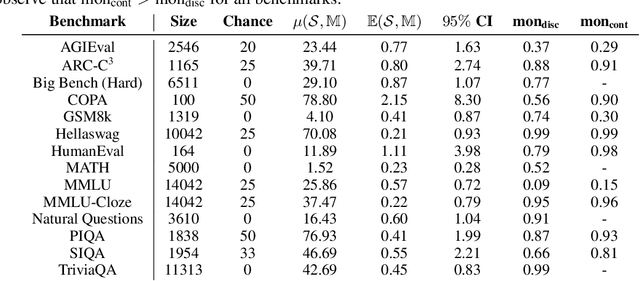
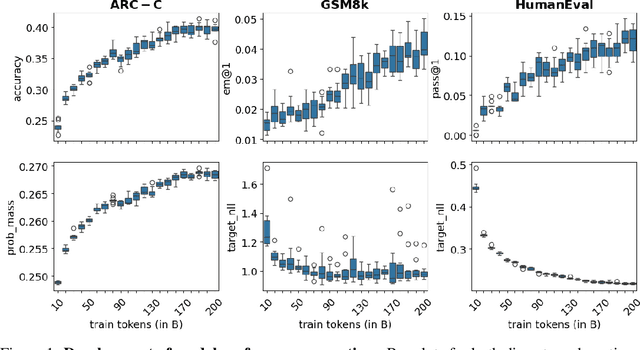

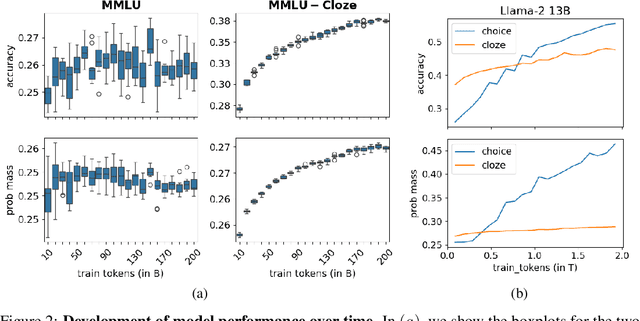
Abstract:Evaluation benchmarks are the cornerstone of measuring capabilities of large language models (LLMs), as well as driving progress in said capabilities. Originally designed to make claims about capabilities (or lack thereof) in fully pretrained models, evaluation benchmarks are now also extensively used to decide between various training choices. Despite this widespread usage, we rarely quantify the variance in our evaluation benchmarks, which dictates whether differences in performance are meaningful. Here, we define and measure a range of metrics geared towards measuring variance in evaluation benchmarks, including seed variance across initialisations, and monotonicity during training. By studying a large number of models -- both openly available and pretrained from scratch -- we provide empirical estimates for a variety of variance metrics, with considerations and recommendations for practitioners. We also evaluate the utility and tradeoffs of continuous versus discrete performance measures and explore options for better understanding and reducing this variance. We find that simple changes, such as framing choice tasks (like MMLU) as completion tasks, can often reduce variance for smaller scale ($\sim$7B) models, while more involved methods inspired from human testing literature (such as item analysis and item response theory) struggle to meaningfully reduce variance. Overall, our work provides insights into variance in evaluation benchmarks, suggests LM-specific techniques to reduce variance, and more generally encourages practitioners to carefully factor in variance when comparing models.
 Add to Chrome
Add to Chrome Add to Firefox
Add to Firefox Add to Edge
Add to Edge